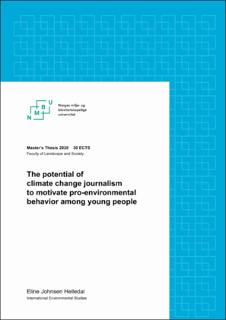| dc.contributor.advisor | Vatn, Arild | |
| dc.contributor.advisor | Aasen, Marianne | |
| dc.contributor.author | Helledal, Eline Johnsen | |
| dc.coverage.spatial | Norway, Oslo | en_US |
| dc.date.accessioned | 2021-01-18T11:11:29Z | |
| dc.date.available | 2021-01-18T11:11:29Z | |
| dc.date.issued | 2020 | |
| dc.identifier.uri | https://hdl.handle.net/11250/2723443 | |
| dc.description.abstract | While global warming is accelerating, we are still far from a solution to climate change. The media plays a key role in engaging the public in order to motivate a transformation towards a future low emission society. This study aims to support CICERO Center for International Climate Research and their research project ACT in understanding how the meaning-making of climate change go about. It touches upon how young people acquire and engage with information about climate change, both in terms of their choice of sources and platforms. In addition, it goes more in-depth into human motivation. The thesis investigates whether climate change journalism can motivate altruistic or pro-environmental behavior among young people. More specifically, what type of reactions, reflections and rationalities that are evoked by a set of articles. The research has a mixed methods approach, where semi-structured in-depth interviews was the main method of data collection. 18 respondents, with an equal representation of gender, participated. These were between 18-29 years old. The analytical framework of the thesis consists of social representation theory, norm activation theory and institutional theory. A total of six journalistic texts were chosen for the quasi-experimental study, which all represented various social representation mechanisms such as emotional anchoring and objectification through personification. The findings suggests that certain mechanisms such as emotional anchoring and anchoring through metaphors have the potential to evoke altruistic reflections among young people. This is so as the articles are able to both increase the awareness of consequences and lead to ascription of responsibility. The same goes for the articles that were linked to habits, which indicates that young people prefer information about everyday action and behavior related to climate change. The remaining articles seem to only increase awareness, but are not able to evoke an ascription of responsibility. Because the materials of the experiment interacts with the participants existing knowledge, norms, and so on, it is useful to think of their reflections as emergent properties. It means that the sum consists of several parts, where each of these affects each other. Therefore, each article provide different results. | en_US |
| dc.language.iso | eng | en_US |
| dc.publisher | Norwegian University of Life Sciences, Ås | en_US |
| dc.rights | Attribution-NoDerivatives 4.0 Internasjonal | * |
| dc.rights.uri | http://creativecommons.org/licenses/by-nd/4.0/deed.no | * |
| dc.subject | climate change journalism | en_US |
| dc.subject | altruism | en_US |
| dc.subject | pro-environmental behavior | en_US |
| dc.subject | institutional theory | en_US |
| dc.subject | social representation theory | en_US |
| dc.subject | norm activation theory | en_US |
| dc.title | The potential of climate change journalism to motivate pro-environmental behavior among young people | en_US |
| dc.type | Master thesis | en_US |
| dc.description.version | submittedVersion | en_US |
| dc.subject.nsi | VDP::Samfunnsvitenskap: 200 | en_US |
| dc.source.pagenumber | 79 | en_US |
| dc.description.localcode | M-IES | en_US |

